Where Do Vehicle Oil Leaks Come From?
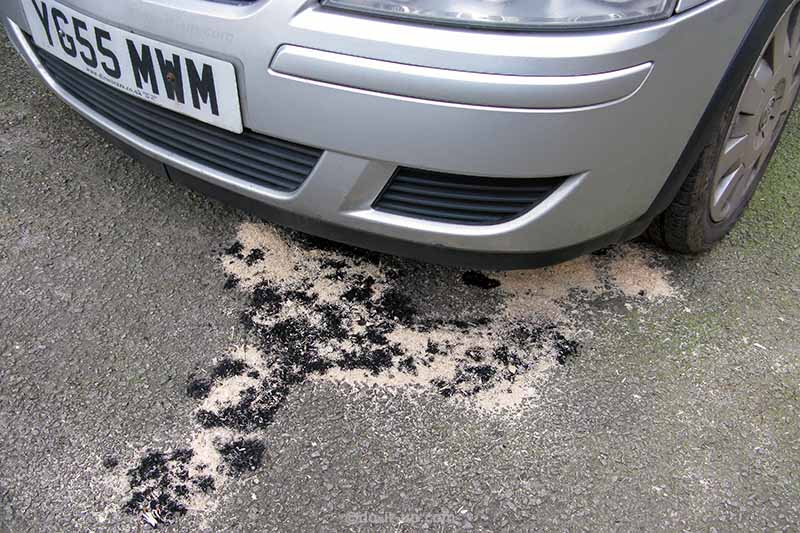
Trying to find an oil leak can be difficult. The engine bays on modern cars are crammed full and all the components are placed on top of each other. You just can’t see where the source of the oil leak is? Often the first thing you see, is the puddle of oil on the floor!
It can be much easier to find a leak, if you know the likely source(s) are (so you can narrow down the search). So, here are the most frequent places where oil leaks can occur…
Where Does the Oil Usually Leak From?
Using the diagram below, here are the most common places to look for an oil leak.
This is in no particular order…
- Where Does the Oil Usually Leak From?
- Common Oil Leaks (the Engine):
- 1. Timing Chain Tensioner:
- 2. Solenoid Valve x 2, (Front & Rear):
- 3. Cylinder Head Cover Gasket:
- 4. Crankshaft Oil Seal (Transmission End):
- 5. Vacuum Pump Gasket:
- 6. Oil Filter Housing Gasket:
- 7. Heat Exchanger, or Oil Cooler (Turbo Charged Models):
- 8. Crankshaft Seal (Timing Chain End):
- 9. Engine Mount:
- 10. Cylinder Head Cover Spark Plug Tube Seals:
- Other Oil Leaks:
- Image Gallery:
Diagram showing where oil leaks can occur (in no particular order):
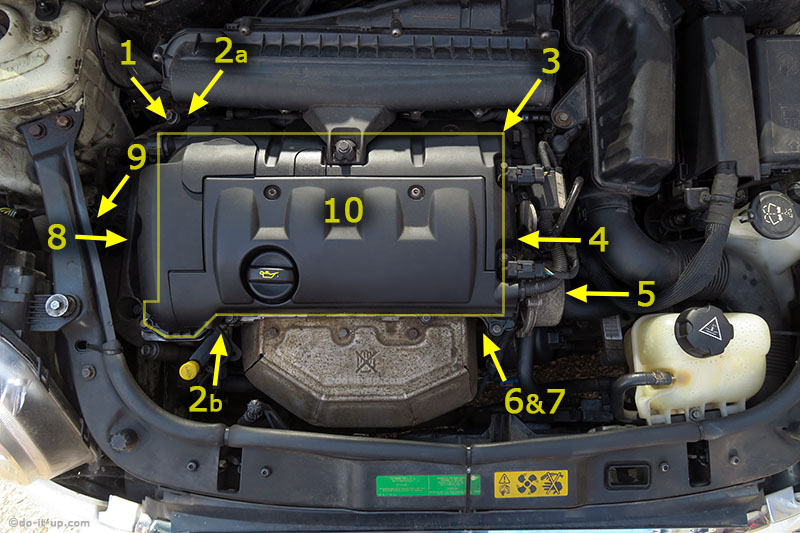
This example is fitted in BMW’s, Citroën’s, Mini’s & Peugeot’s.
Notes:
- Many of the examples here show the 1.6 Litre petrol engine. The ‘Prince Engine‘, used in BMW’s, Citroën’s, Mini’s and Peugeot’s (all these different brands share the same engine, but may have different branded plastic parts, such as engine covers, etc…).
- These oil leaks will also apply to other vehicles…
Common Oil Leaks (the Engine):
1. The Timing Chain Tensioner:

(This example is fitted to a 1.6 Litre Petrol Engine, BMW, Citroën, Mini & Peugeot)
What does it Do?
The timing chain tensioner contains a spring which pushes a piston. The piston applies pressure to the timing chain guide. The guide (with the tensioner), keeps the timing chain under tension and helps prevent timing chain rattle. Which in turn, makes for a quieter engine.
Where Does the Oil Leak?
Oil is fed onto the timing chain to keep it lubricated. If the tensioner has become loose or the sealing washer has failed, oil can escape past the timing chain tensioner and run down the outside of the engine.
How to Fix?
To prevent oil leaks, the timing chain tensioner relies upon it being correctly tightened against its sealing washer. The type of thread used, can also assist in providing an oil seal, (sometimes a finer, or tapered thread is used along with a sealant).
Unfortunately, these ‘bolt like’ tensioners can become loose and oil can leak out.
Luckily though, there is a cheap and easy solution. Cleaning the sealing faces and applying a ‘Thread Lock’ often solves the problem, (along with tightening the timing chain tensioner to the correct torque). The threadlocker prevents the timing chain tensioner from coming undone, due to vibration from the engine. Plus the thread lock can also help provide an additional seal, by preventing oil traveling up the timing chain tensioner thread.
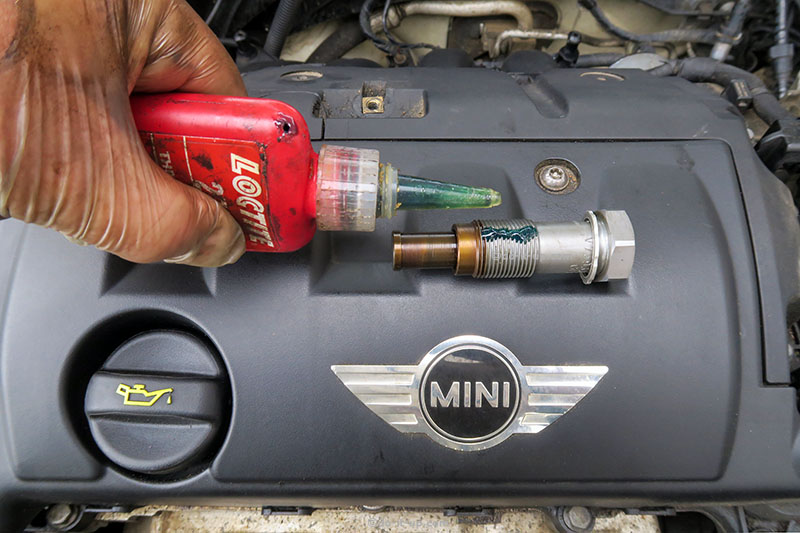
(This example is fitted to a 1.6 Litre Petrol Engine, BMW, Citroën, Mini & Peugeot)
2. The Solenoid Valve, or Vanos x2 (Front & Rear):

(This example is fitted to a 1.6 Litre Petrol Engine, BMW, Citroën, Mini & Peugeot)
What does it Do?
The two solenoid valves, (sometimes called Vanos – Variable Nockenwellensteuerung) control the variable valve timing. There are two camshafts, inlet and outlet. One solenoid at the rear of the engine adjusts the inlet camshaft. The one at the front of the engine adjusts the outlet camshaft.
Where Does the Oil Leak?
- The solenoid slides into a hole and is fixed in place with a bolt. An o-ring on the solenoid shaft provides a seal to prevent the oil from leaking out. When the o’ring fails, oil will then pass the seal running down the outside of the engine.
- The solenoid casing can fail. When the solenoid casing fails, it no longer contains the oil within the solenoid housing. Oil drips from the solenoid casing and runs down the outside of the engine.
How to Fix?
Fixing is fairly straightforward:
Front outlet solenoid:
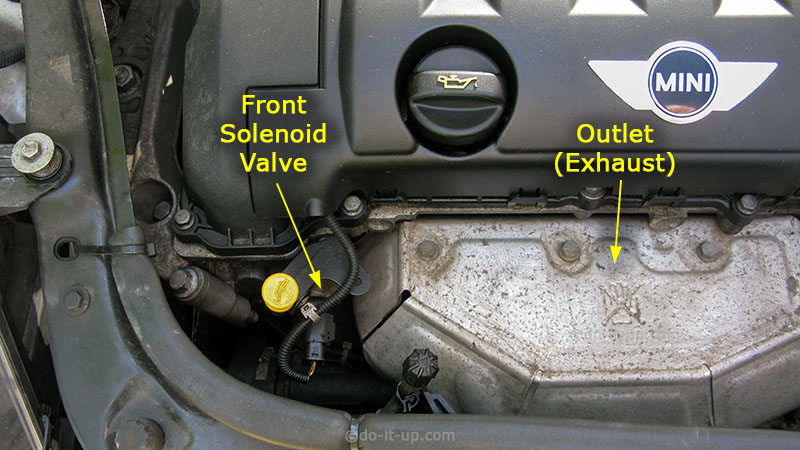
(This example is fitted to a 1.6 Litre Petrol Engine, BMW, Citroën, Mini & Peugeot)
- Unplug and unbolt.
- Replace the solenoid valve.
- Or, replace the o-ring, if this is the failure point. (Please see the note below:)
Rear inlet solenoid:
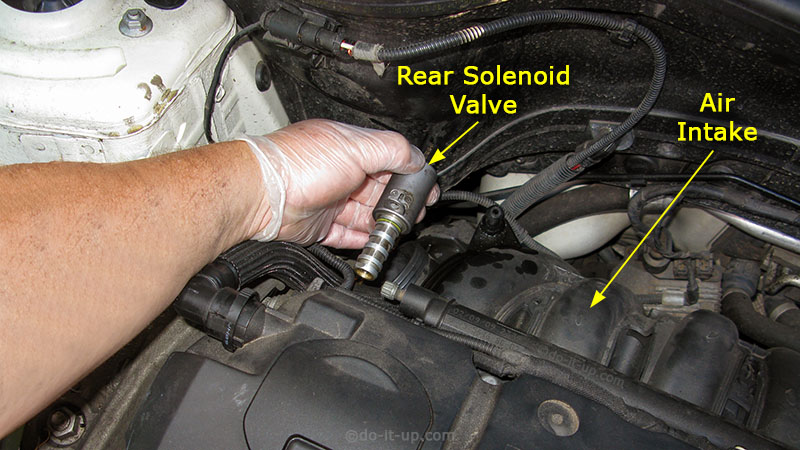
(This example is fitted to a 1.6 Litre Petrol Engine, BMW, Citroën, Mini & Peugeot)
- Move the air filter box and it’s associated pipework out the way.
- Unplug and unbolt.
- Replace the solenoid valve.
- Or, replace the o-ring, if this is the failure point. (Please see the note below:)
Note:
- If replacing the o’ring, you need to be careful to ensure the the correct type of o’ring is used. There are numerous types of o’ring available, all have different characteristics making them less or more suitable for different applications. Failing to use the correct type, will result in the o’ring failing again. See the article: The Different O’Ring Types and Their Properties for more information.
3. The Cylinder Head Cover Gasket:
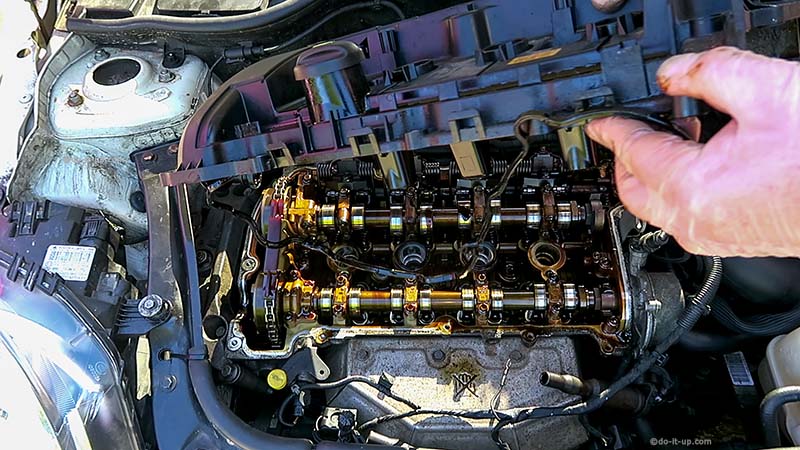
(This example is fitted to a 1.6 Litre Petrol Engine, BMW, Citroën, Mini & Peugeot)
What does it Do?
The cylinder head cover gasket provides an oil seal between the cylinder head plastic cover and the cylinder head.
Where Does the Oil Leak?
The gasket is placed in a recess in the edge of the plastic cover. A leak can occur practically anywhere along the upper edge of the cylinder head and its plastic cover. Over time, the sealing gasket can become compressed and harden and its sealing properties can start to fail.

(This example is fitted to a 1.6 Litre Petrol Engine, BMW, Citroën, Mini & Peugeot)
How to Fix?
You could check for loose cover bolts, by checking each of their torque values, but this often makes little or no difference, (unless they’ve never been tightened correctly).
- The gasket may have deteriorated over time. It becomes compressed and hardens with age, losing its ability to seal.
- Or, the cover may have been over tightened, (which can also result in over compressing and flattening of the gasket, hardening with age losing its seal).
To cure the oil leak usually means removing the plastic cover and replacing the gasket. The bolts must be tightened to the correct value, to ensure an even gap is maintained between the plastic cover and the cylinder head. Over tightening the bolts to try and make a seal can often cause further issues. It may also distort the plastic cylinder head cover, so over tightening should be avoided.
You can often buy the seal as part of a kit, which also contains the seals for the spark plug holes. See 8. The Cylinder Head Cover – The Spark Plug Hole Seals: below…
4. Crankshaft Oil Seal (Transmission End):
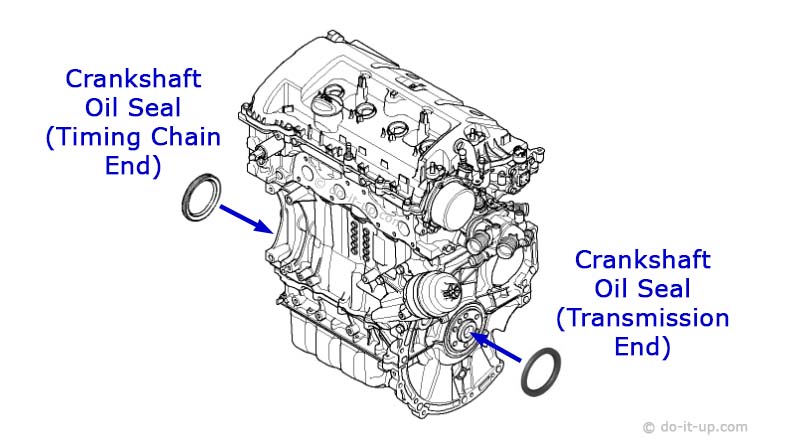
(This example is fitted to a 1.6 Litre Petrol Engine, BMW, Citroën, Mini & Peugeot)
What does it Do?
The crankshaft oil seal sits in a recess in the engine block and provides a seal around the rotating crankshaft, thereby stopping oil escaping from the engine.
Where Does the Oil Leak?
If the seal can become worn, or deteriorates with age. Oil can leak from around the edge of the seal. The seal sits directly behind the clutch and it’s flywheel.
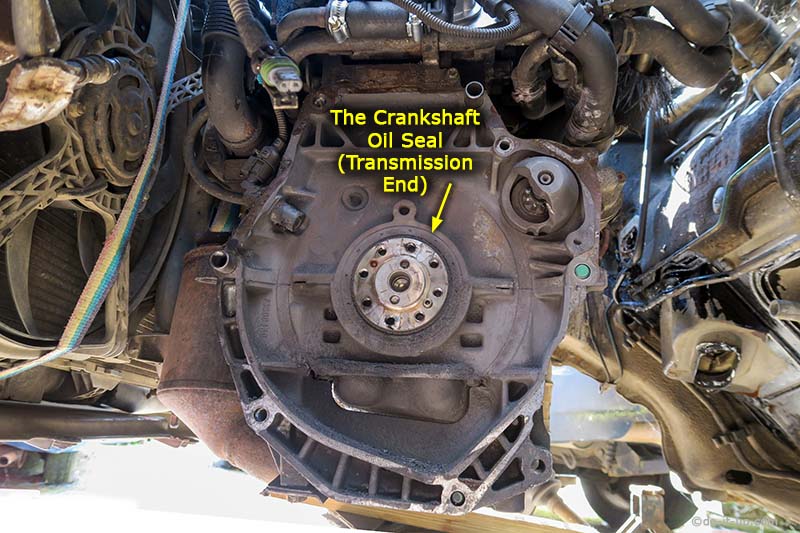
(This example is fitted to a 1.3 Litre Diesel Engine, Fiat, Lancia, Opel, Suzuki & Vauxhall )
How to Fix?
This seal can be difficult to access, because:
- The gearbox has to be removed to gain access..
- The clutch and flywheel then have to be removed.
- Once the gearbox, clutch and flywheel are removed it’s fairly straight forward.
- Gently lever the seal out using a sharp object.
- Replace the seal carefully using a drift tool to evenly insert the seal without distorting it. The drift tool is sometimes supplied with the seal, (a plastic disk that fits over the top of the seal).
Notes:
- For the crankshaft oil seal (transmission end), always check for the source of the leak. As you cannot see the oil seal without removing the gearbox, clutch and flywheel. Several of the other oil leaks can run past this area and make it look like a crankshaft oil seal.
- Clean the area and observe / trace the oil leak, to ensure a correct diagnosis before removing the gearbox.
5. The Vacuum Pump O’Ring Gasket:
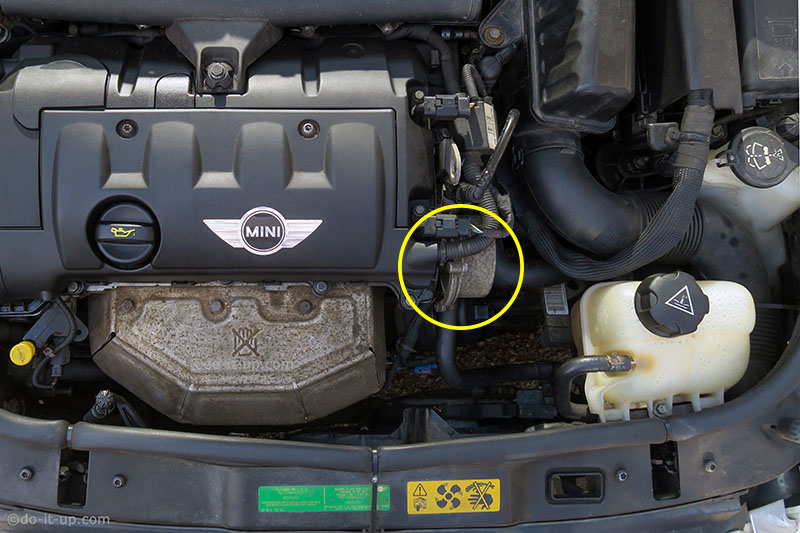
(This example is fitted to a 1.6 Litre Petrol Engine, BMW, Citroën, Mini & Peugeot)
What does it Do?
The vacuum pump provides a vacuum to the brake servo. The brake servo uses the vacuum to provide the power assisted brakes. The Vacuum pump sits on the end of, and is driven by one of the camshafts on the engine cylinder head.
Where Does the Oil Leak?
The o’ring seal (gasket) can fail and oil can leak out.

(This example is fitted to a 1.6 Litre Petrol Engine, BMW, Citroën, Mini & Peugeot)
How to Fix?
This seal is relatively easy to access, by removing:
- The vacuum pump bolts to gain access to the rear of the vacuum pump
Remove and replace with a new o’ring, after ensuring the mating surfaces are clean and undamaged. Torque the fixings to the correct value.
6. The Oil Filter Housing Gasket:

(This example is fitted to a 1.6 Litre Petrol Engine, BMW, Citroën, Mini & Peugeot)
What does it Do?
The oil filter housing directs engine oil from the sump through to the oil filter. The oil then travels from the filter around the engine lubricating as it goes. In addition, there is an extra gasket for cooling water. Cooling water is supplied to the Oil Filter Housing in case a heat exchanger is fitted.
A turbocharged vehicle will have this oil cooler (Heat Exchanger) fitted to the side of the oil filter housing, (see Item 7. Heat Exchanger, or Oil Cooler (Turbo Charged Models): below).
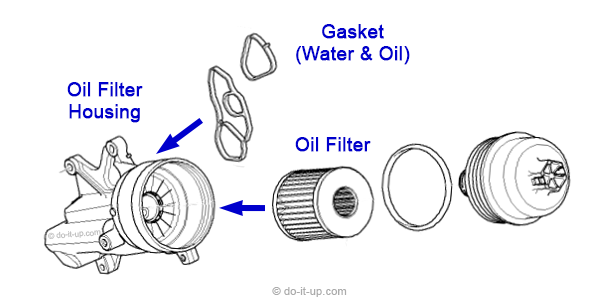
(This example is fitted to a 1.6 Litre Petrol Engine, BMW, Citroën, Mini & Peugeot)
Where Does the Oil Leak?
There is a machined surface on the engine block which mates with the oil filter housing. The oil filter housing has a groove in it’s mating face where an oil seal fits. Over time, the gasket becomes compressed and hardens with age, losing its ability to seal.
How to Fix?
There are two choices when installing new oil filter housing gaskets, (on the mini).
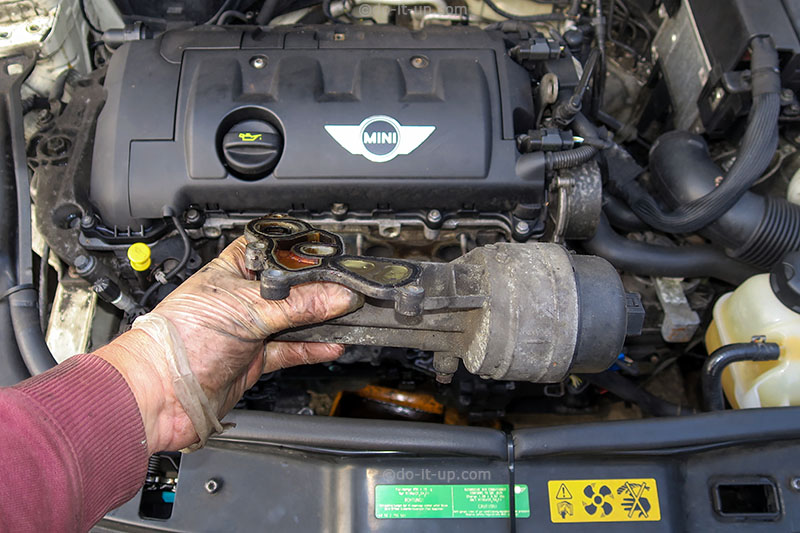
(This example is fitted to a 1.6 Litre Petrol Engine, BMW, Citroën, Mini & Peugeot)
- To put your vehicle into the front end service mode, (also called the radiator support service Position, or front end service position).
- Or, try and take the oil cooler housing off in the limited space?
Putting your vehicle into the front end service mode is straight forward. It just takes time, (lots of fixings to undo). Once in service mode, the job involves removing:
- The top oxygen sensor, and electrically disconnect the lower oxygen sensor.
- The exhaust manifold and catalytic converter covers.
- The exhaust manifold, (to remove the exhaust manifold gasket which hides the oil filter housing bolts). You may need to disconnect the manifold from the exhaust.
- Undo and remove the oil filter housing.
You can do this without going into front end service mode, but space is very limited and you may need a good assortment of different length socket and socket extensions to carry out the task… And a swear box!
7. Heat Exchanger, or Oil Cooler (Turbo Charged Models):
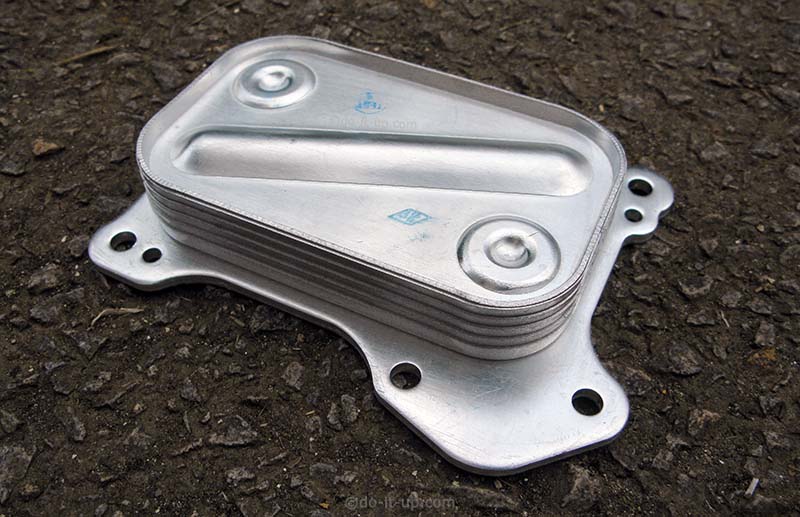
(This example is fitted to a 1.3 Litre Diesel Engine, Fiat, Lancia, Opel, Suzuki & Vauxhall)
What does it Do?
Oil travels to the oil filter through the oil filter housing. It also passes through a heat exchanger, or oil cooler fitted on the side of the oil filter housing, (turbo charged models) .
The oil filter housing directs engine oil from the sump through to the oil filter and the heat exchanger. Once it has passed through the filter and heat exchanger, the oil travels around the engine lubricating as it goes.

(This example is fitted to a 1.6 Litre Petrol Engine, BMW, Citroën, Mini & Peugeot)
Where Does the Oil Leak?
- There are machined surfaces on the engine block and heat exchanger. These mate with the machined surfaces on the oil filter housing, which also has a series of grooves for inserting the gaskets. Over time, the gaskets can become compressed. They also harden and become brittle with age, losing their ability to seal.
- It’s not unknown for oil coolers \ heat exchangers to fail internally. When this happens, oil can enter the cooling system and water can enter the oil ways and engine sump. The first signs of this happening is a combination of:
- Increase in engine temperature.
- Oil in the expansion tank.
- Water on the oil dipstick.
How to Fix?
There are two choices when installing new heat exchanger (and oil filter housing?) gaskets (on the mini).
- To put your vehicle into the front end service mode, (also called the radiator support service Position, or front end service position).
- Or, try and take the heat exchanger (and oil filter housing?) off in the limited space?
Putting your vehicle into the front end service mode is straight forward. It just takes time, (lots of fixings to undo). Once in service mode, the job involves removing:
- The top oxygen sensor, and electrically disconnect the lower oxygen sensor.
- The exhaust manifold and catalytic converter covers.
- The exhaust manifold, (to remove the exhaust manifold gasket which hides the heat exchanger and oil filter housing bolts). You may need to disconnect the manifold from the exhaust.
- Undo and remove the heat exchanger and oil filter housing.
You can do this without going into front end service mode, but space is very limited and you may need a good assortment of different length socket and socket extensions to carry out the task… And a swear box!
Notes:
- Whilst you’re changing the heat exchanger gaskets. It’s probably well worth changing the oil filter housing gaskets at the same time, to save repeating the (very similar) task later on…
8. Crankshaft Oil Seal (Timing Chain End):

(This example is fitted to a 1.6 Litre Petrol Engine, BMW, Citroën, Mini & Peugeot)
What does it Do?
The crankshaft oil seal sits in a recess in the engine block and provides a seal around the rotating crankshaft, thereby stopping oil escaping from the engine.
Where Does the Oil Leak?
If the seal can become worn, or deteriorates with age. Oil can leak from around the edge of the seal. The seal sits directly behind the crankshaft pulley wheel, (see the image above).

(This example is fitted to a 1.6 Litre Petrol Engine, BMW, Citroën, Mini & Peugeot)
How to Fix?
This seal is relatively easy to access, by:
- Removing the vehicles front wheel (adjacent to the crankshaft pulley).
- Loosening the wheel arch liner to gain access.
- Removing the drive Belt.
- Removing the crankshaft pulley wheel.
- Gently lever the seal out using a sharp object.
- Replace the seal carefully using a drift tool to evenly insert the seal without distorting it. The drift tool is sometimes supplied with the seal, (a plastic disk that fits over the top of the seal).
9. The Engine Mount (Right Hand Side):
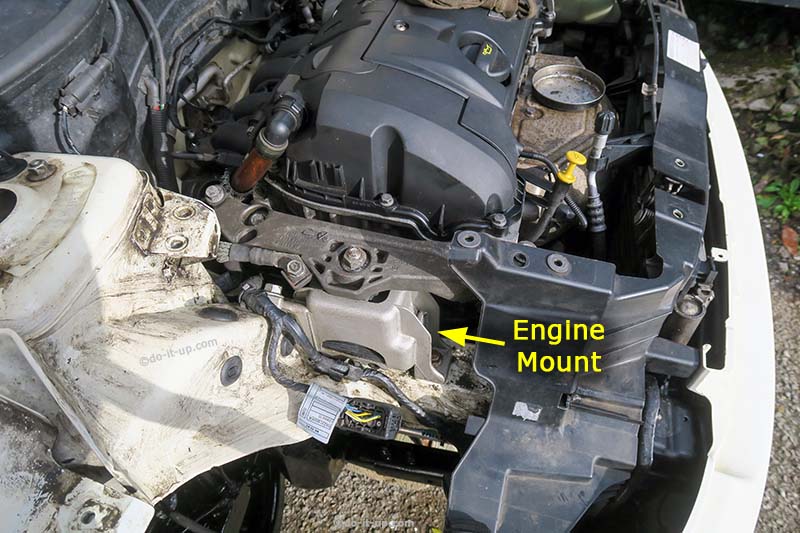
(This example is fitted to a 1.6 Litre Petrol Engine, BMW, Citroën, Mini & Peugeot)
What does it Do?
The engine mount supports the engine and holds it in place. It stops the engine moving and twisting under acceleration and deceleration. It also prevents vibrations from the engine being transferred to the body of the vehicle.
Where Does the Oil Leak?
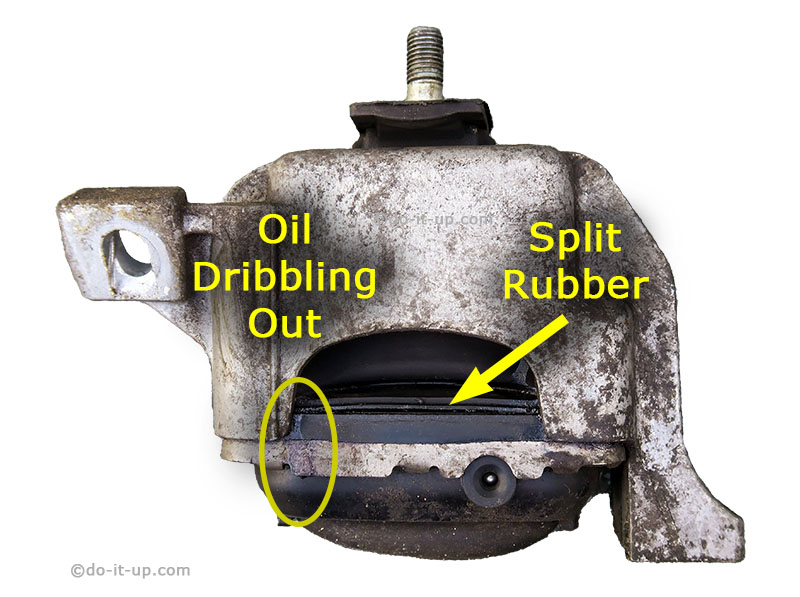
(This example is fitted to a 1.6 Litre Petrol Engine, BMW, Citroën, Mini & Peugeot)
The rubber part of the engine mount can have an oil filled cavity. The joint can start to split and oil can leak out.
How to Fix?
The engine needs to be supported on a jack whilst the engine mount is swapped out. Place the jack under the engine sump, ensuring the jack is well clear of the oil sump drain plug. Use a piece of wood (or other suitable material), between the jack and the sump to protect the sump from damage.
Notes:
- The engine mount fitted at the factory, (right hand side whilst sitting in the vehicle) are often oil filled. The replacements may not have an oil cavity, but are made from solid rubber. No more oil leaks…
10. The Cylinder Head Cover – The Spark Plug Tube Oil Seals:
When you check your spark plugs, you may find the ignition coils, the spark plugs, and the spark plug holes are covered in oil…
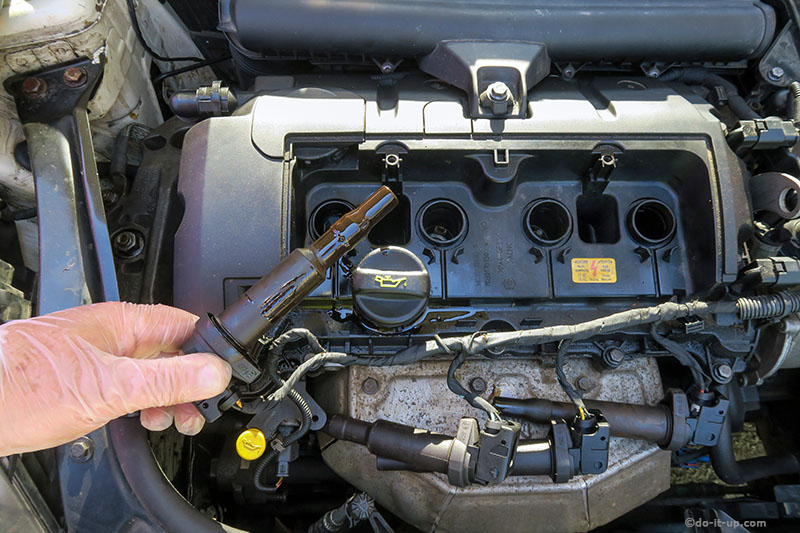
(This example is fitted to a 1.6 Litre Petrol Engine, BMW, Citroën, Mini & Peugeot)
What do they Do?
The top of the cylinder head will have oil pumped to it to lubricate the valve mechanism and camshafts. The spark plug tube oil seals prevent oil from leaking into the spark plug holes. If any of the seals fail, the holes can fill with oil.
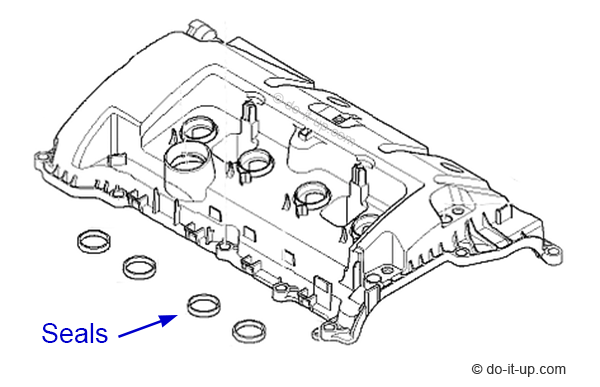
(This example is fitted to a 1.6 Litre Petrol Engine, BMW, Citroën, Mini & Peugeot)
Where Does the Oil Leak?
Oil can leak into the spark plug holes.

(This example is fitted to a 1.6 Litre Petrol Engine, BMW, Citroën, Mini & Peugeot)
How to Fix?
Remove the cylinder head cover and replace the seals. You often buy the seals as part of a kit, which may also contain a seal for the cylinder head cover itself. See 3. Cylinder Head Cover Gasket: above…
Other Oil Leaks:
Power Steering:
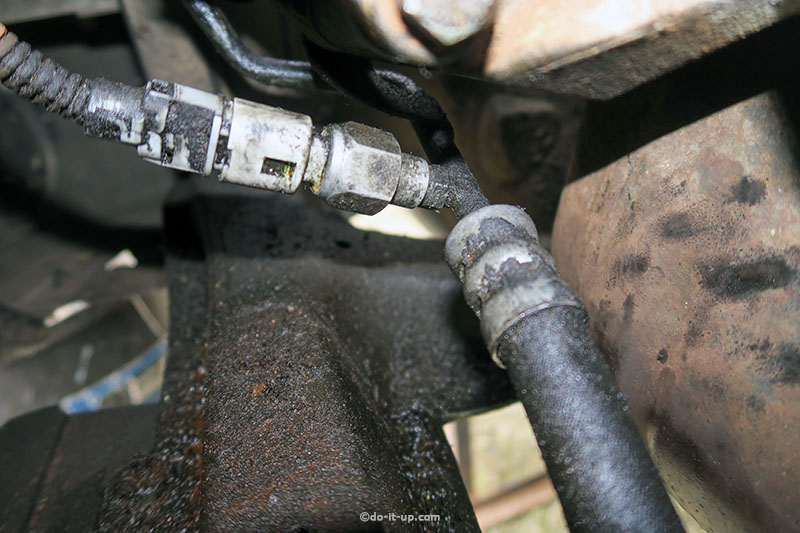
(This example is fitted to a 1.2 Litre Petrol Engine, Dacia, Nissan, Opel, Renault, Saab, Vauxhall)
What Does Hydraulic Power Steering Do?
Hydraulics are used to assist in changing the direction of the wheels, (when turning the steering wheel). This makes it easier to manoeuvre the vehicle when parking, or turning the vehicle at slow speeds. A hydraulic pump is used to create the pressure. This pressurised oil is fed to the steering rack via solid and flexible pipes.
Important:
- This only applies if you have hydraulic power steering fitted. Many vehicles now have electric power steering.
- How can you tell? There will be a hydraulic oil reservoir for the power steering, that can be topped up with power steering fluid (oil). This is usually in the engine bay.
- Don’t mistake the brake fluid reservoir for the power steering reservoir…
Where Does the Oil Leak?
The hydraulic power steering oil, can leak anywhere in the system. It usually occurs where there is a:
- A leaking joint.
- A split flexible hose.
- Corrosion, or from chafing.
- Worn seals.
- From a leaking pressure switch.
Caution!
The hydraulic oil may be pressurised. To protect yourself from oil being ejected under pressure, please follow the safety precautions and wear the appropriate safety equipment, safety glasses, gloves etc...
How to Fix?
The general area of the leak will be apparent from being covered in oil. However, it’s never that simple as the oil may have leaked from one place, but caused an oily mess in an adjacent area (see the image above). If it’s not obvious where the leak is coming from, wipe down and clean the area so you can visually observe and trace the leak as it occurs.
Image Gallery:
– click or tap the image to view full size –























